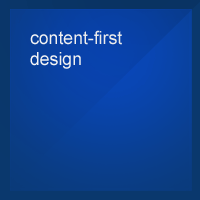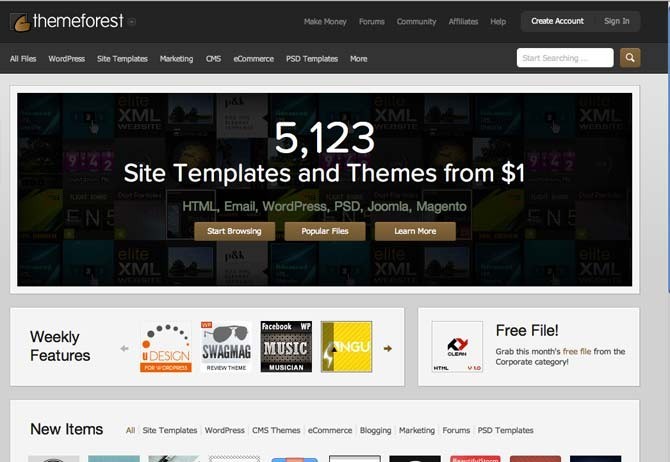Design As A Commodity
Category: Web Business - Published: Feb 28, 2012 - Tags: design clients web content
More and more people are beginning to believe that design is a commodity. It is a small problem now, but will continue to grow as time goes on. Cheap, good looking websites are becoming easier and easier to make and with far lower learning curves. Creating a website for some people is the same thing as buying a car, you pick out the one you like and take it home, and we as designers are largely to blame.
You don’t have to look far online to find tons of people who believe this very thing. All of the money making blogs, affiliate marketing websites, and blogs on blogging all say, find a cheap but professional looking template, find a web designer for $10 an hour to put it together, get a $40 logo and you are good to go. For the most part these are pretty internet savvy individuals who know what works and what they are talking about. The sad thing is, for 80% of the websites out there, it actually works quite well. And I would even go as far as saying this would be a big improvement for a lot of the websites currently out there that cost a whole lot more money to make.
There are some really exceptional web templates out there on the market for free or for a small fee, usually under $50. And maybe you don’t want to admit it, but some of them are better than the design you are currently putting together and charging thousands of dollars for.
You may argue that your clients need a custom design that fits their brand and are willing to pay the extra money for it. We live in a world where there is competition after all, and if a better design can give competitive advantage, companies will spend the money to do so. But it is hard to deny the fact that it is getting easier and easier for people with limited web knowledge to quickly put together pretty decent looking websites for free, or very close to it. Or simply bypassing a website completely and taking advantage of social media and free blogging platforms.
Personally, I don’t believe design should ever be a commodity but the problem is, we web designers have made it so. We don’t design websites. We create content shells. We make pretty little design elements that surround the real important stuff that lives inside it. And every day that goes by, it becomes easier and easier for clients to find these content shells online for cheap or free and plug in their data, without paying you anything.
Web designs are not pretty shells to hold your content, they are the content.
We as web designers have distanced ourselves so much from the content, that we have stopped designing for the content itself and started designing homes for the content to live in. And track homes is the future of the web if we don’t decide to make some changes. Well, that change is inevitable for much of the web, but if we want to work with the good clients who actually care about and understand the benefit of design, we need to start designing for content again. But of course there is more to it than that.
Over the course of this wacky ride that has been the evolution of the internet, web design has primarily centered around interface design. We started with very crude tools, tables and html, and did what we could with it. As our tools improved our interface design skills also improved, as did interface design standards. Almost now to the point where web design is on par with print design. But we have not really gone to the next step. We still design an interface and put content into it, instead of designing the content within a website.
Track Homes, The Future of the Internet
The problem is, we are coming to the point where the best practices for interface design have been created. There are standards now. We can use and reuse the same code bits and design elements. It is no longer design. We are building the same elements over and over. And it doesn’t take people long to realize that the process can be done cheaper and faster or become more automated. There are frameworks and CMSes, website templates, and free UI elements. Creativity is no longer needed and creativity is what dictates high prices. Interface design is becoming a factory job on the assembly line, just churning out the same parts over and over. And pretty soon the factory jobs get outsourced to places with cheaper workers or the work becomes automated.
As an example of other commodities, just look at the mobile phone industry. There used to be innovative new designs when the market was new. Now there are 100 phones that look like the Iphone. This is what happens with commodities. One person innovates and the rest copy what works. Here is an interesting article about the commoditization of design in the electronics field. Interface design is going to go down that path but web design doesn’t have to, if we continue to push the envelope.
Interface design has largely come to the point where there is not a lot of innovation to be done. There are changes ahead, the shift from desktop to mobile will continue and touch will become increasingly important. But really, those aren’t major innovations in interface design, the same rules will still apply. Innovation takes creativity. When creativity is no longer needed, the cost of production drops dramatically. In our industry’s case, look at the design template business.
Look at the tagline on Themeforest, “5123 Site Templates and Themes for $1”. The only people making any real money from those templates is Themeforest themselves. But that is where the web is going. Interface designs are simple to put together so they shouldn’t cost much of anything to produce.
Social media is also putting a squeeze on the web design industry. Not every company needs a website and not every website needs a good design. And you can do very well just using a free Blogger or Wordpress account, Twitter, Facebook, Google Plus and so on without a custom website. Take a look at these examples of horrendous web design on highly successful websites. When news and content is of utmost concern the design doesn’t really matter. Or in social media’s case, everyone can use the same ugly interface. We all can live within Facebook’s ugly blue walls and be perfectly happy.
Just like every company doesn’t really have a brand, every company doesn’t need good design. If you are in jail you look in the phonebook for a bail bondsmen. You probably pick the first one you see. It doesn’t really matter what their ad looks like. The same is true for many businesses. I think so many companies have believed they need a website because of a lack of understanding about the internet rather than an actual need for one. A lot of businesses only need a $100 website. It sucks to say it but it is true. In the future people will begin to take a closer look at their web presence and really question whether they need to drop the cash to hire a web designer. As web designers we need to be ready for this. Some clients really don’t need our services but the ones that do, we need to be able to explain how our services helps their bottom line. I’ll get into this in a lot more detail in upcoming posts.
Content management systems have also played a large role in separating content from design. We create little boxes and content areas for clients to add their own content but never spend any time designing within that space, aside from setting a font size. As CMSes continue to improve they will get simpler to use and develop sites with. That doesn’t necessarily mean less time will be spent on design, more that web design becomes that much easier and cheaper to do.
Creativity is the Key
Templates work because the bar is set so amazingly low. When everyone’s design is equally boring we are more ok with it. We are so familiar with the web that we don’t really realize how much it really sucks. In ten years we will look back and laugh at todays internet just as we laugh at the work we created ten years ago. For web designers, the thing to realize is that we are past the point of just creating interfaces to house content, we need to move beyond that and begin designing the content itself, in order for our industry to evolve.
Web design is not just interface design. Interface design has reached the high water mark but luckily we have more important areas to focus on. Web design is about increasing, improving, and creating conversions. Web design is about building brands. Web design is marketing and advertising and sales and customer service and supply chain management and everything else in business. A web design should encompass all that a business is within it’s walls. And we need to be the people who understand all of these processes and how to make them work. We will have even more value but the challenges will be that much greater.
So if you are building template based websites I would start to worry about your carrier in the future as profits continue to get stretched tighter and tighter. But if you want to remain creative and well paid, sharpen your business and critical thinking skills. Because there will still be plenty of businesses looking to get ahead of their competition, they just need smart people to turn to, to do it.
The next installment in this series will be about Design Communication, or sometimes the lack thereof in the design process. In upcoming posts I will talk more about adding value to design by aligning it with key business goals. I will also go over how designing for content will be vital in the future for our industry.
This is the first post in a long series of posts eventually leading up to the Content-First Design process. Thanks for reading, and if you have any questions, agree or totally disagree with anything I’ve said go ahead and let me know in the comments below.

